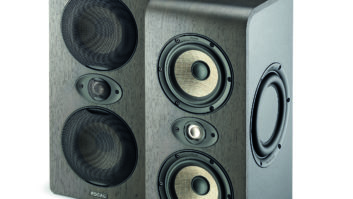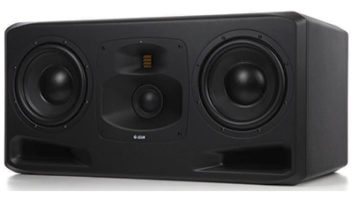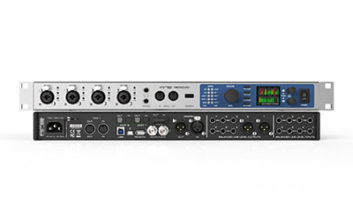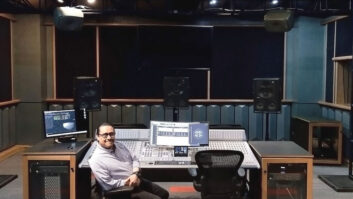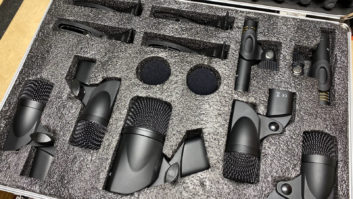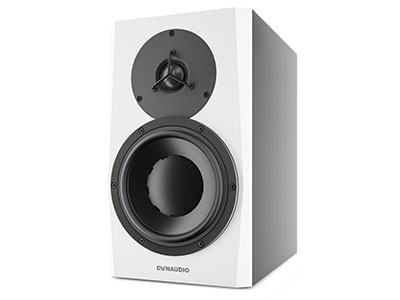
The LYD 7 is Danish manufacturer Dynaudio’s mid-sized model in its new LYD Series of near-field monitors. Featuring a 7-inch woofer and 28mm (1.1-inch) soft-dome tweeter, the monitor’s small footprint—7.32×12.6×11.65 inches (WxHxD)—makes it well suited for use in home studios, edit rooms and other small setups where space is at a premium.
Separate 50-watt Class-D amps power the monitor’s tweeter and woofer. A switch-selectable standby mode shuts down the amplifiers when audio is not detected at the monitor’s input. The woofer’s aluminum voice coil has a relatively low mass to enhance transient response; it surrounds a ferrite magnet system with vented pole piece. Notably, the woofer’s diaphragm and dust cap are molded into one piece from Dynaudio’s proprietary magnesium silicate polymer; its construction reportedly optimizes the woofer’s stiffness, weight and dampening. The monitor’s crossover frequency is 4.3 kHz.
On the LYD 7’s back plate, a flared bass slot augments bass extension. The analog inputs are non-latching XLR (accepting either balanced or unbalanced connections) and unbalanced RCA. The three-way Sensitivity switch should be set to -6 dB when using the LYD 7 with pro audio gear, +6 dB when interfacing with consumer equipment, and 0 dB for use with gear using intermediate operating levels. The monitor’s max SPL per pair is stated to be 109 dB at 1 meter—plenty loud.
That’s a Switch
On the back panel, onboard DSP—implemented using three switches—lets you adjust the LYD 7’s frequency response for the desired bass extension and to compensate for the speaker’s room placement and the room’s degree of acoustic dampening. The three-way Bass Extension switch adjusts the low-frequency cutoff ±10 Hz from nominal response. The nominal “0 Hz” setting provides a frequency response that’s down 6 dB at 55 Hz and 21 kHz. The +10 Hz setting raises the monitor’s bass cutoff to 65 Hz, while the -10 Hz setting lowers it to 45 Hz (all bass-extension specs reference the same -6dB limit).
The two-way Position switch adjusts the LYD 7’s response for freestanding placement (Free setting) or for situating the speakers within 50 cm (20 inches) of a wall (Wall setting). The free-field frequency response, when using the -10Hz Bass Extension setting, is 55 Hz to 19k Hz ±2 dB. Dynaudio’s frequency-response plots show unattenuated response well over 10 kHz when listening up to 20 degrees off-axis on the horizontal plane. The vertical sweet spot is much more narrow for accurate reproduction of frequencies between 5 and 6k Hz; if you orient the LYD 7 vertically (which Dynaudio recommends for the best time-alignment of bass and high frequencies), you should ensure that the monitor is angled so that the tweeters are aimed directly at your ears.
The LYD 7’s three-way Sound Balance switch provides for either a neutral frequency response or one that respectively mitigates an especially damped or live room. The Bright setting—for use in a heavily damped room—boosts the monitor’s response 1.5 dB at 20 kHz while simultaneously cutting the same amount at 20 Hz. The Dark setting inverts the Bright setting’s spectral tilt, boosting 1.5 dB at 20 Hz and cutting 1.5 dB at 20 kHz. To prevent phase problems from arising, both the Bright and Dark settings use tilt filters—with a 1kHz midpoint—instead of shelving equalization.
A power switch, power-status LED and IEC power receptacle (for the detachable six-foot AC cord) finish off the back plate’s feature set. I wish the status LED were mounted on the LYD 7’s front baffle, so I could tell whether the monitor was on without squeezing behind my mixing console for a look. On a positive note for itinerant engineers, the LYD 7 will sense the incoming voltage and automatically adapt to 120V or 220V.
Powering Up
For my listening tests, I placed a stereo pair of LYD 7s in a vertical orientation on a pair of Primacoustic Recoil Stabilizers, which were in turn placed on the shelves of my console’s furniture. An ASC Attack Wall at the front of my control room tightens imaging and impulse response. RPG Skyline Diffusors at the rear of my room scatter reflections off the back wall in a de-correlated hemispheric pattern, preserving the perceived phase response of direct sound at the mix position.
With the LYD 7s’ rear-panel switches set up for freestanding placement, neutral Sound Balance and the deepest bass extension, I went to work. I immediately noticed the monitors’ outstanding depth and imaging, including a rock-solid phantom center. The transient response was also awesome, and not because of peaky high-frequency reproduction; the highs sounded smooth and were non-fatiguing. Bass extension was good for such a small monitor, but you’ll want to pair the LYD 7s with a sub to get the bottom octave-and-a-half in proper perspective while mixing.
Now for nitpicks: With the Bass Extension switch set to -10 Hz to produce the deepest lows, the bass band sounded quite tubby and muddy. The “0 Hz” setting sounded better, but still not flat and tight enough for my liking. The “+10 Hz” setting sounded the flattest to my ears, but middle- and upper-bass frequencies still sounded a little muddy with that setup. I don’t want to overstate this issue, as the LYD 7’s bass reproduction—using the +10 Hz setting—sounded better than with most ported near-fields. It just didn’t sound as good as with the best models I’ve reviewed (including monitors from Yamaha and JBL that cost considerably less). Orienting the monitors horizontally—with tweeters positioned to the outside—didn’t help clear up the bottom end. Using the Wall setting was also of no benefit; it attenuated the bottom end too much, which was predictable seeing as each monitor was positioned about three feet from the nearest wall.
No matter how I set the LYD 7s’ DSP switches, the upper-midrange band also sounded slightly understated. While using the Bright (Sound Balance) setting made the monitor’s bottom end sound more balanced, it also made the LYD 7 sound a bit top heavy and the mild upper-midrange deficit a little more apparent—electric guitars, for example, sounded very detailed but slightly thin.
The Bottom Line
The LYD 7 sounded better than most of the ported near-fields I’ve heard over the years. However, its relatively high price (in a crowded market for monitors) makes me expect near perfection. Even after tweaking the DSP settings every which way, it still suffers—if just slightly—from the muddy bass reproduction that is all too common in its product category. Still, the LYD 7’s performance is positively outstanding in so many other regards that it’s well worth an audition.
PRODUCT SUMMARY
COMPANY: Dynaudio
PRODUCT: LYD 7
WEBSITE: www.dynaudio.com
PRICE: $1,778/pair list
PROS: Outstanding depth, imaging, and transient response. Built-in DSP. Solid build-quality.
CONS: Bass reproduction could be tighter and flatter. A bit pricey. Power-status LED is located on the back plate.
TRY THIS
If your monitors—of any make and model—have a rectangular cabinet, and you use them on Primacoustic Recoil Stabilizers, you’ll often get the tightest and flattest bass response if you place the monitors on their sides (horizontally oriented). The greater the surface area making contact with the Recoil Stabilizers, the greater the decoupling.

